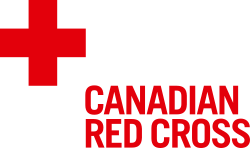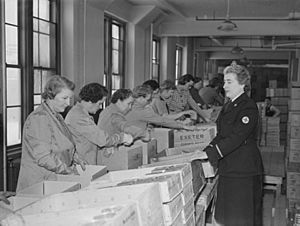Canadian Red Cross facts for kids
 |
|
| Founded | 1896 |
|---|---|
| Type | Charitable organization |
| Headquarters | Ottawa, Ontario |
| The Governor General of Canada | |
The Canadian Red Cross Society (French: La Société canadienne de la Croix-Rouge) is a Canadian humanitarian charitable organization, and one of 192 national Red Cross and Red Crescent societies. The organization receives funding from both private donations and from Canadian government departments.
The Canadian Red Cross trains volunteers in emergency response, disaster response, and disaster assistance, and provides injury prevention services such as outdoor activities safety and first aid training. The society, through the international network of the Red Cross, helps the world's vulnerable populations, including victims of armed conflicts and communities destroyed by disasters. The Canadian Red Cross also handled the Canadian blood supply, until that responsibility was taken away from them in the aftermath of the tainted blood scandal.
The current Secretary General and Chief Executive Officer of the Canadian Red Cross is Conrad Sauvé.
History

The Canadian Red Cross was established in the fall of 1896 as an affiliate of the British Red Cross Society (then known as the National Society for Aid to the Sick and Wounded in War). George Ryerson, who had founded Canada's St. John Ambulance Association in 1895, spearheaded the organization's founding. The Canadian Red Cross Society Act (1909) legally established the Red Cross as the corporate body in Canada responsible for providing volunteer aid in accordance with the Geneva Conventions.
The first international activity of the Canadian Red Cross was treating the sick and wounded in South Africa during the Boer War.
After the end of World War I in 1918, the Society began training public health nurses. The Wilberforce Red Cross Outpost was established in 1922. A children's program designed to promote healthy living, the Junior Red Cross, was set up in schools across Canada.
For many years the Canadian Red Cross was responsible for collecting human blood from donors for medical use. The Ottawa Branch of Canadian Blood Services operated from a building on Metcalf Street which was donated by Mary Alice Danner in memory of Flight Sergeant William Dewey Hagyard R.C.A.F. who was missing in action in WWII. The branch later relocated to Plymouth Street. In 1998, after serious flaws in the blood collection process were uncovered, the Society stopped providing this service.
The Canadian Red Cross had its centennial celebration in May 2009. In 2017 the Red Cross provided food, shelter and medicine to asylum seekers crossing the border into Canada from the United States.
Programs in Canada
Emergencies and disasters
The Canadian Red Cross provides assistance to Canadians experiencing an emergency or disaster. The organization works in partnership with government, first responders, emergency management, and other organizations to support their response activities. They also provide assistance for people's basic needs, which includes: family reunification, lodging, reception and information, food, clothing, and personal services, such as first aid, temporary care for children or elderly, and other support.
In February 2022, Canada Red Cross launched a program to support the long-term recovery needs of people impacted by the flooding and extreme weather events in British Columbia that began on November 14, 2021. The organization provided financial support to people from eligible households to help cover their interim housing and basic needs while they transition to longer-term housing.
Community health services
Community support services
The Canadian Red Cross offers a range of community support services that provide daily supports to older adults, vulnerable people, and their caregivers. The goal of these programs is to provide support in maintaining quality of life, independence, and active participation in society. Some of the programs and services available include: nutrition support programs (such as Meals on Wheels), social inclusion programs, assisted living in supportive housing and attendant outreach services, safety programs, and transportation. The availability of these programs varies. The Red Cross also provides services to homeless people during extreme weather.
Health Equipment Loan Program (HELP)
This program provides health equipment to individuals dealing with illness or injury, enabling them to return home from the hospital sooner or live more independently. The program operates in British Columbia, Alberta, New Brunswick, Prince Edward Island, Nova Scotia, Newfoundland and Labrador, and the Yukon Territory. The types of assistive equipment that can be provided include: wheelchairs, walkers, bath seats and benches, commodes and toilet seats, crutches and canes, bed handles, and other durable medical equipment. The program is funded through financial donations as well as through the donation of used medical equipment, diverting it from the landfill, and it carried out with the support of volunteers and the health authorities.
Home care services
The Canadian Red Cross offers personal support and homemaking services to support the independent living of seniors and those recovering from illness or injury. These services include: personal care, home management, and respite and companion care. Home care services are available in Nova Scotia, New Brunswick, and Ontario.
Migrant and refugee services
The Canadian Red Cross has been involved in the independent monitoring of detention facilities holding immigration detainees since 1999, following a request from Citizenship and Immigration Canada (CIC). The organization provides independent monitoring to determine if detainees are treated humanely and their human rights and inherent dignity are respected. As of 2014, this includes visiting federal immigration holding facilities and some provincial correctional facilities in Québéc, Ontario, Alberta, British Columbia, and Manitoba.
Safety, first aid, and CPR
The Canadian Red Cross is involved in treating the wounded on the fields of war and to training individuals to effectively handle emergencies both at home and in the workplace. The organization has been offering first aid and CPR training to Canadians for over 50 years. In an average year, about 600,000 Canadians are trained.
In 1946 the Red Cross Swimming and Water Safety programs were introduced as a result of a large number of drownings that occurred in Canada in the 1940s. Since then, more than 30 million Canadians, in more than 3,500 communities across Canada were to taught to swim and stay safe around water. The swimming program ended in 2022 to direct more attention to humanitarian efforts as the operations were transferred to the Lifesaving Society.
In 2012, The Canadian Red Cross and Lifesaving Society joined forces with the Public Health Agency of Canada to launch the Open Water Wisdom initiative, which is a community water activity safety program which promotes awareness of water safety issues nationally, including to remote communities across Canada.
International programs
Emergencies and disasters
The Canadian Red Cross delivers primary healthcare programs, relief supplies, water, and sanitation and shelter solutions to vulnerable communities affected by conflict, disasters, and health emergencies. The Society's international programming supports community-based programs that provide large-scale humanitarian aid.
International development
The Canadian Red Cross has long-term development programs in the regions of Africa, the Americas, Asia, and the Middle East and North Africa.
Maternal, newborn, and child health
The Canadian Red Cross supports community-based health programs which address preventable illness in mothers and children, including malaria, pneumonia, diarrhea, and malnutrition, particularly in remote areas where there is a lack of health services and emergencies where health services have collapsed. They also provide education about reproduction, newborn care and breastfeeding, nutrition for young children, hygiene, sanitation, and methods of accessing potable water.
See also

